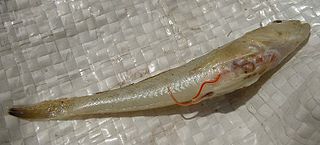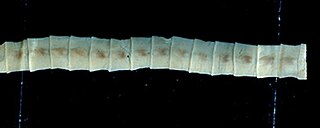
Karl Asmund Rudolphi was a Swedish-born German naturalist, who is credited with being the "father of helminthology".

Ascaris is a nematode genus of parasitic worms known as the "small intestinal roundworms", which is a type of parasitic worm. One species, Ascaris lumbricoides, affects humans and causes the disease ascariasis. Another species, Ascaris suum, typically infects pigs. Other ascarid genera infect other animals, such as Parascaris equorum, the equine roundworm, and Toxocara and Toxascaris, which infect dogs and cats.

Helminthology is the study of parasitic worms (helminths). The field studies the taxonomy of helminths and their effects on their hosts.

The blue bird-of-paradise is a beautiful, relatively large species of bird-of-paradise. It is the only species in the genus Paradisornis, but was previously included in the genus Paradisaea.

Johann August Ephraim Goeze was a German zoologist, born in Aschersleben. He is known for the discovery of tardigrades, also called water bears. He was the son of Johann Heinrich and Catherine Margarete. He studied theology at University of Halle. He married Leopoldine Maria Keller in 1770, by whom he had four children. In 1751, he became a pastor in Aschersleben, in Quedlinburg, and later of St. Blasius' Church in Quedlinburg in 1762, finally becoming first deacon of the seminary of Quedlinburg in 1787. He died in Quedlinburg.

The thorny-headed worm family Polymorphidae contains endoparasites which as adults feed mainly in fish and aquatic birds. When this taxon was erected by Meyer in 1931, a subfamily Polymorphinae was established in it. As the Polymorphidae as presently understood would then be monotypic, with no basal genera outside the Polymorphinae, the proposed subfamily is redundant for the time being and therefore most modern treatments simply omit it. Polymorphus minutus is an economically significant parasite in goose and duck farming.

Echinorhynchus is a genus of acanthocephalan parasitic worms. They parasitize a wide variety of fishes from both marine and fresh waters. The intermediate host is usually a crustacean.

Oligacanthorhynchida is an order containing a single parasitic worm family, Oligacanthorhynchidae, that attach themselves to the intestinal wall of terrestrial vertebrates.
Plagiorhynchidae is a family of parasitic Acanthocephalan worms.
Polymorphus is a genus of parasitic worms from the phylum Acanthocephala. This group uses amphipod crustaceans as intermediate hosts and various birds as final hosts.

Pogonocherus is a genus of flat-faced longhorn beetles in the family Cerambycidae.

Eustrongylides is a genus of nematodes belonging to the family Dioctophymidae. The species of this genus cause eustrongylidosis.
Uncinaria is a genus of nematode. The genus was circumscribed by Josef Aloys Frölich in 1789.

Scymnus is a genus of beetle in the family Coccinellidae. It is the type genus of the subfamily Scymninae and the tribe Scymnini.

Diplodoma laichartingella is a moth belonging to the genus Diplodoma. The species was first described by Johann August Ephraim Goeze in 1783.
Choanotaenia is a genus of flatworms belonging to the family Dilepididae.

Bothriocephalus is a genus of flatworms belonging to the family Bothriocephalidae.
Rodentoleptis is a genus of tapeworms belonging to the family Hymenolepididae.
Goezia is a genus of nematodes belonging to the family Raphidascarididae.
Baruscapillaria is a genus of nematodes belonging to the family Capillariidae.












